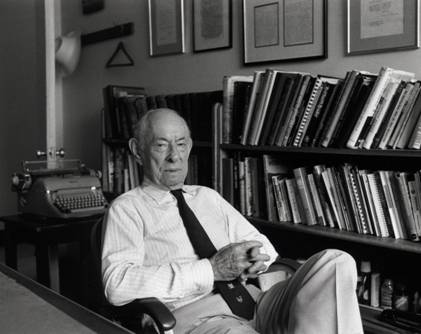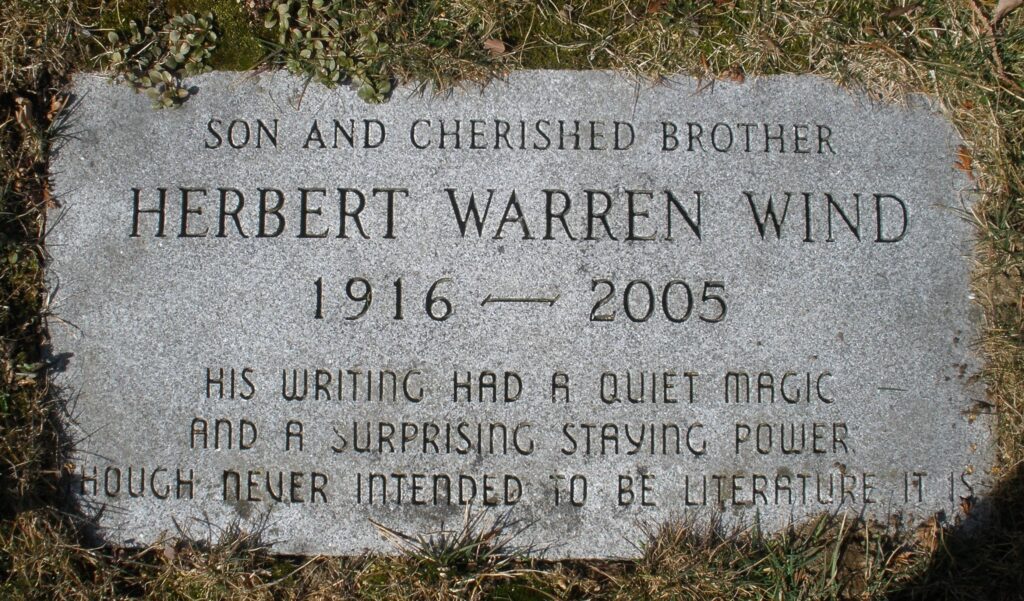
Herbert Warren Wind – Born 1916, Died 2005, AGW Member 1973-2005
Wikipedia
Early years
Born in Brockton, Massachusetts, Wind began golf at age seven at the Thorny Lea Golf Club in Brockton, and played whenever he could. He graduated from Yale University, where he contributed to campus humor magazine The Yale Record.[2] He earned a master’s degree in English Literature from the University of Cambridge. At Cambridge, Wind became friends with the noted British golf writer Bernard Darwin, a grandson of evolutionist Charles Darwin.
Wind was a low handicapper who played golf well enough to compete in the 1950 British Amateur Championship, and maintained a lifelong interest in the sport.
Life and career
Wind began writing for The New Yorker in 1941, covered golf and sometimes other sports for that weekly magazine from 1947 until 1953, and again from 1960 until his retirement in 1990. From 1954 to 1960, he covered golf and sometimes other sports for Sports Illustrated magazine. Although associated with golf, Wind wrote articles on a wide range of sports including tennis, squash, basketball, and football.
In 1958, Wind coined the phrase ‘Amen Corner’ to describe the second shot at the 11th, all of the 12th, and the tee shot at the 13th hole at the Augusta National Golf Club, site of the annual Masters Tournament.[3] That nickname, which is derived from a 1935 song that Wind had heard while a student at Yale, “Shoutin’ in that Amen Corner” written by Andy Razaf, which was recorded by the Dorsey Brothers Orchestra, vocal by Mildred Bailey (Brunswick label No. 6655). Wind covered more than 30 Masters tournaments.
His first book was The Story of American Golf, which first appeared in 1948, and was updated and re-issued twice, the most recent in 1975. This book was the most comprehensive history of American golf to that juncture. Along with Ben Hogan, Wind co-authored Five Lessons: The Modern Fundamentals of Golf in 1957.
This book has become one of the all-time classics of golf instruction, and has been re-issued many times.He was a co-author of the 1976 book The World Atlas of Golf, a popular survey of the world’s top golf courses, which has been re-issued since in several revised editions.
In 1983, with the help of Robert Macdonald, Herbert Warren Wind co-founded and curated the Classics of Golf Library—a collection of the world’s greatest golf literature. Under the guidance of Wind, the Classics of Golf Library was created to preserve and make available the works of the leading authors of early and modern golf literature. Wind and Macdonald reprinted these classic golf books and added Forewords and Afterwords to provide insight and perspective to the great literary works. Sixty-nine books make up the Classics of Golf Library today, which is featured in the USGA Museum.
In 1992, the PGA of America honored Wind with its lifetime achievement award. The United States Golf Association presented Wind with the Bob Jones Award, its highest award, in 1995, the centennial of the USGA. He is the only writer to receive the award. In 2006, the United States Golf Association renamed its annual Book Award in his honor. Wind was elected to the World Golf Hall of Fame in 2008 in the Lifetime Achievement category.[4]
Wind died in Bedford, Massachusetts at age 88.

Selected books
Wind wrote or edited a number of books in addition to his numerous articles for magazines. His The Story of American Golf is considered a seminal work on the subject.
- The Complete Golfer, by Herbert Warren Wind, New York, Simon & Schuster, 1954.
- Game, Set, and Match: the Tennis Boom of the 1960s and 70s, by Herbert Warren Wind, New York, E.P. Dutton, 1979, ISBN 0-525-11140-9.
- The Gilded Age of Sport
- Great Stories from the World of Sport, co-editor with Peter Schwed
- The Greatest Game of All with Jack Nicklaus
- Herbert Warren Wind’s Golf Book, by Herbert Warren Wind, New York, Simon & Schuster, 1971, ISBN 0-671-20808-X.
- Five Lessons: The Modern Fundamentals of Golf, by Ben Hogan and Herbert Warren Wind, 1957, ISBN 0-434-98105-2.
- On the Tour with Harry Sprague: Letters of a Golf Pro to His Sponsor, with an introduction by Jimmy Demaret, New York, Simon and Schuster, 1960.
- Playing Through
- The Realm of Sport, editor
- The Story of American Golf, by Herbert Warren Wind, Classics of Golf, 1948 (1st ed.) and 1975 (3rd ed.), ISBN 0-394-49020-7.
- Thirty Years of Championship Golf with Gene Sarazen
- Tips from the Top, editor
- Following Through, by Herbert Warren Wind, New York, Ticknor & Fields, 1985, ISBN 0-89919-398-6.
- The Encyclopedia of Golf, by Donald Steel and Peter Ryde American Advisory Editor: Herbert Warren Wind, New York, The Viking Press New York, 1975, ISBN 0-670-29401-2.
- The World of P.G. Wodehouse, by Herbert Warren Wind, Praeger, 1972, ISBN 0-09-145670-3.
Articles
- Wind, Herbert Warren (October 13, 1986). “The Sporting Scene: Mainly about Chris Evert Lloyd”. The New Yorker. Vol. 62, no. 34. pp. 117–145.
- Wind, Herbert Warren (September 22, 1975). “The House of Baedeker”. The New Yorker.
Herbert Warren Wind, Golf Writer, Dies at 88
By Frank Litsky appearing in the New York Timesm
June 1, 2005
Herbert Warren Wind, whose richly detailed prose graced the pages of The New Yorker and Sports Illustrated for 43 years and established him as the dean of American golf writers, died Monday in an assisted-living facility in Bedford, Mass. He was 88.
The cause was pneumonia, said his nephew, Bill Scheft, a columnist for Sports Illustrated.
Mr. Wind was a short, slender, serious man who wore a tweed jacket, shirt, tie and cap on the golf course, even in the hottest weather. A graduate of Yale with a master’s degree from Cambridge, he wrote with an elegant but straightforward style that showed respect for his subject, whether it was golf, his first love, or other sports like tennis and baseball.
“Every time you read him, you get a history lesson, a golf lesson and a life lesson,” the professional golfer Ben Crenshaw said.
Mr. Wind’s narrative powers were displayed in a profile of Arnold Palmer for The Sporting Scene in The New Yorker of June 9, 1962
“Let us say he is a stroke behind, with the holes running out, as he mounts the tee to play a long par 4,” Mr. Wind wrote. “The fairway is lined by some 10,000 straining spectators — Arnold’s Army, as the sportswriters have chosen to call them — and a shrill cry goes up as he cuts loose a long drive, practically lifting himself off his feet in his effort to release every last ounce of power at the moment of impact. He moves down the fairway toward the ball in long, eager strides, a cigarette in his hand, his eyes on the distant green as he considers every aspect of his coming approach shot. They are eyes with warmth and humor in them as well as determination, for this is a mild and pleasant man. Palmer’s chief attraction, for all that, is his dashing style of play. He is always attacking the course, being temperamentally incapable of paying it safe instead of shooting directly at the flag.”
Mr. Wind was a staff writer for The New Yorker from 1947 to 1954. He left to write for the new magazine Sports Illustrated. In 1962, he returned to The New Yorker and stayed there until he retired.
His first writing in The New Yorker was a poem in 1941 and his last was a review of the 1989 United States Open tennis championship. Of the 141 articles he wrote for the magazine, 132 were for the section called The Sporting Scene. Although those reports appeared well after a competition ended, they were eagerly awaited by the participants, fans and colleagues in the news media.
Mr. Wind was born Aug. 11, 1916, in Brockton, Mass., and was raised there. He started playing golf as a youngster, and his first hero was Bobby Jones, who recorded golf’s first Grand Slam as an amateur in 1930.
In 2001, Mr. Wind told The Boston Globe that his passion for golf stemmed from a radio program on Friday evening in his youth.
“Bob Jones used to do this radio show with Grantland Rice,” Mr. Wind recalled. “It was marvelous, so informative. They taught us about the game. Educators, they were.”
Writing in Sports Illustrated on Palmer’s victory in the 1958 Masters, Mr. Wind coined the name that still stands for the treacherous stretch of the Augusta National course on the 11th, 12th and 13th holes. He recalled a jazz record he had bought in college of a spiritual called “Shoutin’ in the Amen Corner” and named that part of the course Amen Corner.
He wrote or edited more than a dozen golf books.
In an article for Golf Digest in 1970, he wrote that golf was “the ‘official’ game of our era, the common ground, the shared enthusiasm, the Cloth of Gold that drew together the heroes from such separate worlds as sports, government and entertainment.”
In 1992, the Professional Golfers Association presented Mr. Wind with its lifetime achievement award. In 1995, the United States Golf Association gave him its annual Bob Jones Award for distinguished sportsmanship in golf. Previous winners included Palmer, Jack Nicklaus, Ben Hogan, Byron Nelson and Babe Zaharias, but never a writer. Mr. Wind’s reaction was typical: “I’m flabbergasted and feel undeserving.”
Mr. Wind never married. He is survived by a brother, Jack, of Brockton, Mass.; and three sisters: Martha Finger of Providence, R.I.; Gertrude Scheft of Weston, Mass.; and Rose Stone of Plymouth, Mass
The author John Updike was Mr. Wind’s colleague at The New Yorker.
“He really gave you a heaping measure of his love of the game,” Mr. Updike said. “He was so knowing, so perceptive. He could play, too. About a decade ago, I took him to the Myopia course in Hamilton, Mass. He walked with me when I played a few holes, but I couldn’t get him to hit the ball. I suspect he didn’t think he could do it as well as he once did.”
Mr. Wind’s love affair with golf and the Masters never waned. At age 84, more than 10 years removed from his last trip to the Masters, he asked another golf writer, “Tell me, is Augusta still beautiful?”
ARTICLE BY AGW MEMBER – JERRY TARDE (Golf Digest – Nov 3rd, 2008)
https://www.golfdigest.com/story/tarde-2008-12

Recent Comments